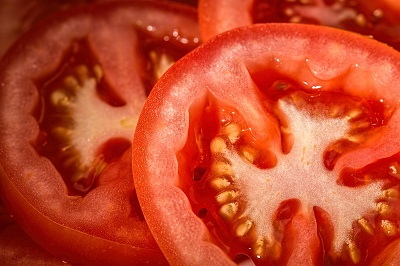Tomatoes have a lot of minerals,tomatoes is most rewarding of vegetables. Tomatoes are easy to grow from seed, can be grown in any size garden. Small tomatoes can be grown on windowsill. Most of the people is combing through seed catalogs, buying seeds and carefully planting tomato seedlings. Which is absolutely old way to grow tomatoes. Check this out easy-peasy tomato slice method.
Jump to
In this way tomato seedlings can grow in few days. You only need pot, some soil and one overripe tomato. Sounds easy? It is!
First of all, cut a overripe tomato one quarter-inch thick. After that put tomato slices onto a pot of compost. Then throw soil over the tomatoes pieces until they are almost covered. Water the pot periodically. You should end up with from 40 to 60 new tomato seedlings in week or two.
Tomato Seedlings growing tip
Growing tomato seedlings the aim is to create single-stemmed plant, unless you are growing a bush tomato. To do single-stemmed tomato plant, snap out shoots that grow in leaf joints and when your tomato plant has produced four sets of flowering trusses, pinch out the growing tip. In this way tomato plant energy goes into producing fruit. Water tomato plants daily and once little tomato vegetables started to appear, feed tomato plant with fertiliser every week to ensure the best quality vegetable.
Training tomato plants
Tomato plant training will depend on the varieties and types of tomatoes grown. You may see varieties called as ‘cordon’, ‘indeterminate’ or ‘determinate’. Lets understand what does it mean.

Indeterminate – most common tomato variety. These varieties grown as single stemmed plants with side shoots removed. These tomatoes grow very tall, sometimes taller than 2,5 height in very warm conditions.

Bush/Determinate – these varieties stop growing sooner than indeterminate varieties with the stem ending in a fruit truss. Determinates stop growing when fruit sets on the top bud. All the tomatoes from the plant ripen at approximately the same time (usually over period of 1- 2 weeks). They are referred to as ‘bush’ and ‘dwarf’ types (most suitable as hanging basket tomatoes) and require a limited amount of staking for support and are perfectly suited for container planting.
Semi-determinate – very similar to indeterminate variety. These tomatoes grow short, have lesser (compared to determinate) and the length of each branch is longer, these varieties require the support of a pole of 1 metre lenth, to avoid trailing in the ground. The plant height comes to almost 1-2 metres. Pruning to maintain the apical dominance will not be effective and lead to reduced yields.
With indeterminate and semi-determinate varieties (cordons), tie the plants to a support as they grow. You will notice side-shoots appearing where the leaf stems joins the main stem (the leaf axil). Regularly pinching out of tomato side shoots will concentrate the plant’s energy into producing fruit. When the cordon has reached the top of its support, cut out the tip of the main stem 2 leaves above the top flower truss. For the best quality fruit it’s best to let no more than 6 fruit trusses form on the plant. If the tomato plant hasn’t reached the top of its support by late summer, cut out the main tip anyway to allow the remaining fruits time to ripen.
Determinate varieties (bush/dwarf types) don’t require any pruning or training and will happily sprawl along the ground or pot they’re growing in. Determinate varieties may stop flower production after several trusses, but upward growth can be carried on by training up the topmost side shoot.
Common problems growing tomatoes
Tomato blight

One of the most common problems when growing tomatoes is tomato blight, which spreads quickly throughout the plant in wet weather, causing the plant to die and the fruits to decay. The symptoms are brown patches on all parts of the plant. It is much more common in tomatoes growing outside than tomatoes growing in a greenhouse. You can prevent blight infection by spraying Bordeaux Mixture on your plants in early summer. Growing blight resistant tomato varieties will also help to overcome this fungal disease.
Fruit problems

Most tomato fruit problems are caused by irregular watering. Examples include ‘Blossom End Rot’ (dark patch at the base of the fruit, more common if the plant is grown in a grow bag), ‘Blossom Drop’ (flower bud falls off), ‘Dry Set’ (fruitlet growth stops when the fruit is the size of a match-head), and ‘Fruit Splitting’. The key is to give your tomatoes an even, regular amount of water at the base of the plant. Too much water too late tends to be the problem in most cases, especially with plants grown in pots and grow bags.
Other problems tend to be caused by too much direct sunlight. Tomatoes need high light intensity to grow well, but too much can cause blotches, scalds or spots on the developing fruit. ‘Greenback’ is a common problem caused by too much sunlight, leaving the ripe fruit with a hard green area on its ‘shoulder’. If this is a problem increase the potassium in the plants’ feeding regime and use fleece or shading as a cover in the hottest part of the day. It may also help to use resistant varieties such as ‘Alicante’ or ‘Craigella’.
Insect pests

As with most plants look out for green and white fly – both can spread viruses. Spray with a recommended insecticide as soon as any pest is noticed or for organic gardening use a natural pest control. Planting marigolds such as ‘Tomato Growing Secret’ and similar flowers will attract beneficial insects that will eat the pests.
Leaf problems

If leaf yellowing starts on the older leaves and moves upwards it may not be a virus but a deficiency of magnesium. It is a common problem which is not serious if the plant is otherwise vigorous. It can be remedied by using a special magnesium feed if required but this is not essential.
You may also notice curling of the leaves; this can be caused by aphids sucking the sap out of the leaves. If there is no sign of insects then it is most likely caused by cold temperatures at night (more noticeable in early summer) and this is nothing to worry about. If you notice anything unusual affecting both younger and older leaves such as mosaic patterns, streaks or distorted leaf surfaces, your tomatoes may have a virus. If you believe your tomatoes do have a virus, the plant or plants must be removed and destroyed as there is no cure for viruses. Avoid handling other tomatoes, or using the same tools on your tomatoes until the tools have been thoroughly sterilised and your hands washed in hot soapy water.
Controlling sunlight and temperature levels will avoid extremes which cause disorders. Avoid erratic watering, keeping soil constantly moist.
Tomato splitting and cracking

Cracking or splitting usually does not affect the taste of the tomato, but split fruit left on the plant will often be infected by a fungus, such as grey mould and can cause a variety of physiological disorders.
Control temperature and sunlight levels carefully. Feed regularly to maintain high soil fertility. Water to maintain a constant level of soil moisture.
Harvesting tomatoes
Start picking when the fruit is ripe and fully coloured. At the end of the growing season lift the plants with unripe fruit and either lay them on straw under cloches or hang them in a cool shed to ripen. Or you can, pick the green fruit and store in a drawer next to a banana, which aids ripening.
Start picking your tomatoes as the fruits ripen and gain full colour. When frost threatens at the end of the season, lift any plants with unripe fruit on them and hang them upside down under cover. Tomatoes can be successfully frozen if you find you have a glut.

In this way I always have beautiful tomato seedlings, which will be used for my indoor garden. The best way to plant more than one tomato seedling, because there is a good chance that one of them might not make it. Please SHARE this helpful trick with your friends!

